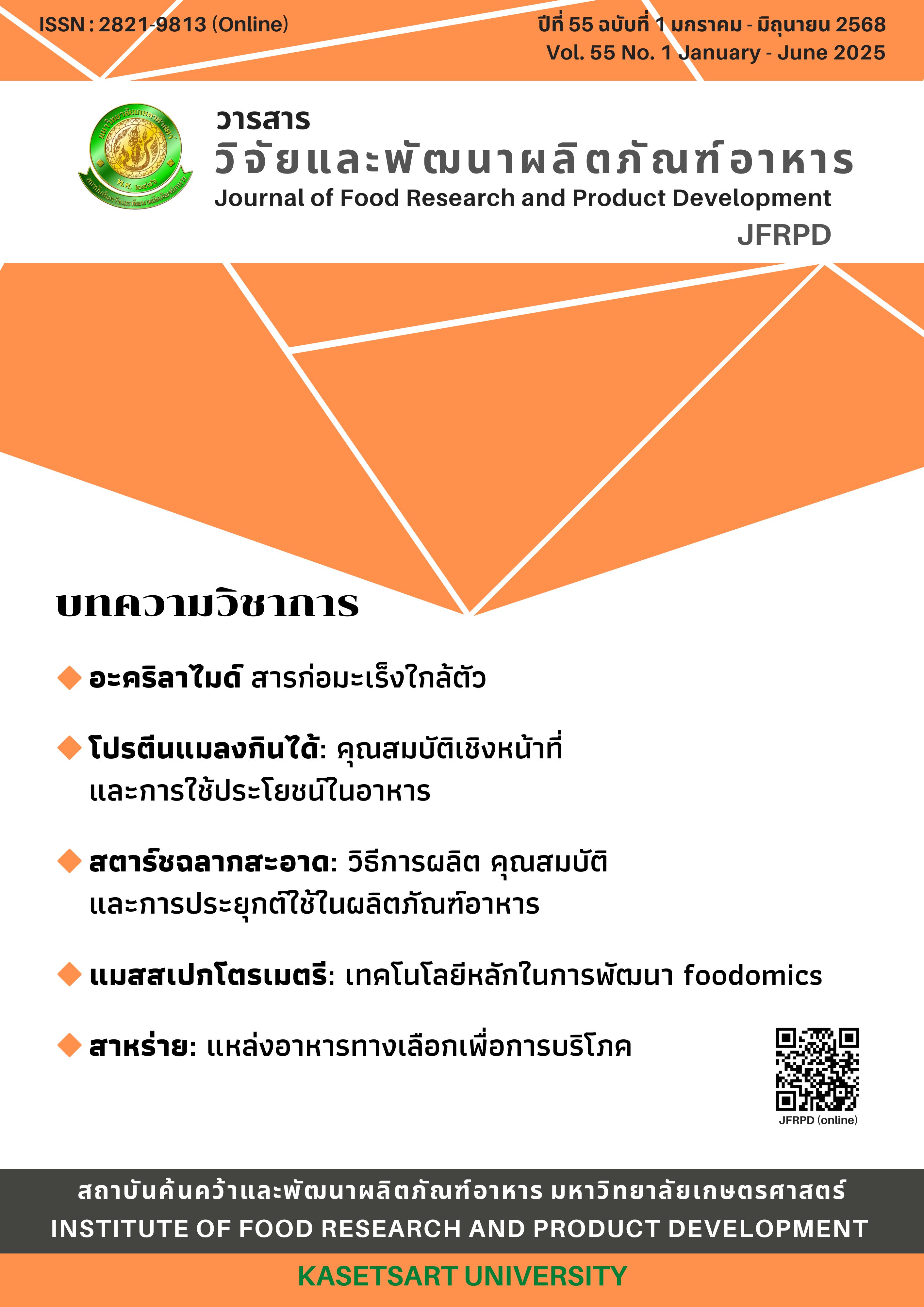Mass spectrometry: A key technology in advancing foodomics
Main Article Content
Abstract
Mass spectrometry (MS) has emerged as a powerful technique revolutionizing the field of food analysis. MS provides unparalleled insights into their chemical composition by precisely identifying and quantifying molecules within foods. Its versatility makes it invaluable for various food analysis applications, particularly in foodomics - a discipline integrating food science, chemistry, and omics to explore the complex chemical makeup of foods and their relation to quality, health, and safety. MS can accurately identify and quantify metabolites, proteins, and other compounds in foods, detect contaminants and allergens, and investigate correlations between food composition and consumer health. Popular techniques include LC-MS, GC-MS, and MALDI-TOF MS, each suited for analyzing different types of compounds. As a robust analytical tool, MS is driving research in foodomics. Providing molecular-level insights into food composition aids in developing high-quality and safe food products and promoting consumer health. With ongoing advancements, MS is poised to address future food challenges, such as sustainable food production, developing health-promoting foods, and ensuring rapid and accurate food quality assessment.
Downloads
Article Details

This work is licensed under a Creative Commons Attribution-NonCommercial-NoDerivatives 4.0 International License.
References
Labster. Mass Spectrometer. Available from: https://theory.labster.com/mass-spectrometer
Cifuentes A. Food analysis and foodomics. J Chromatogr A. 2009;1216:7109-7110.
Valdés A, Álvarez RG, Socas RB, Herrero M, Ibáñez E, Cifuentes A. Foodomics: Analytical opportunities and challenges. Anal Chem. 2022;94:366-381.
Zhang, S, Qi X, Naggar Y, Wu L, Wang K. Understanding the gastrointestinal protective effects of polyphenols using foodomics-based approaches. Frontiers in Immunology. 2021;12:671150.
Mozzi F, Ortiz ME, Bleckwedel J, De Vuyst L, Pescuma M. Metabolomics as a tool for the comprehensive understanding of fermented and functional foods with lactic acid bacteria. Food Res Int. 2013;54:1152-1161.
Cevallos J, Corcuera J, Etxeberria E, Danyluk M, Rodrick G. Metabolomic analysis in food science: a review. Trends Food Sci Technol. 2009;20:557-566.
Monton J, Soga T. Metabolome analysis by capillary electrophoresis-mass spectrometry, J Chromatogr A. 2007;1168:237-246.
Geographical origin authentication via elemental fingerprint of food [Internet]. JRC Publications Repository; [cited 2025 Apr 18]. Available from: https://publications.jrc.ec.europa.eu/repository/bitstream/JRC132521/JRC132521_01.pdf
Y. Zhang, "Application of isotope analysis for food authenticity and traceability: Progress and challenges," Master's thesis, University of Virginia, 2015.
Zhao J, Li A, Jin X, Liang G, Pan L. Discrimination of geographical origin of agricultural products from small-scale districts by widely targeted metabolomics with a case study on pinggu peach. Front Nutr. 2022;9:891302. doi: 10.3389/fnut.2022.891302
Hidalgo MJ, Gaiad JE, Goicoechea HC, Mendoza A, Pérez-Rodríguez M, Pellerano RG. Geographical origin identification of mandarin fruits by analyzing fingerprint signatures based on multielemental composition. Food Chem X. 2023;20:101040.
Kussmann M, Fay L. Foodomics: Advanced mass spectrometry in modern food science and nutrition. 2013;167-189.
Gill BD, Saldo SC, McGrail IJ, Wood JE, Indyk HE. Rapid method for the determination of thiamine and pantothenic acid in infant formula and milk-based nutritional products by liquid chromatography‒tandem mass spectrometry. J AOAC Int. 2020;103(3):812–817.
Ross KL, Dalluge JJ. Liquid chromatography/tandem mass spectrometry of glycolytic intermediates: deconvolution of coeluting structural isomers based on unique product ion ratios. Anal Chem. 2009 May 15;81(10):4021-6.
Baniasadi H, Vlahakis C, Hazebroek J, Zhong C, Asiago V. Effect of environment and genotype on commercial maize hybrids using LC/MS-Based metabolomics. J Agric Food Chem. 2014;62(6):1412-1422.
Van den Abbeele P, Poppe J, Deyaert S, Laurie I, Otto Gravert TK, Abrahamsson A, Baudot A, Karnik K, Risso D. Low-no-calorie sweeteners exert marked compound-specific impact on the human gut microbiota ex vivo. Int J Food Sci Nutr. 2023 Sep;74(5):630-644.
Geißler K, Greule M, Schäfer U, et al. Vanilla authenticity control by DNA barcoding and isotope data aggregation. Flavour Fragr J. 2017;32:228–237.





